Find more information in the General Comments section of the assessment
Find more information in the Rating Validity tab of the assessment
- See More
- See More
- See More
- See More
- Good
- Adequate
- Marginal
- Weak
- Poor
 Passenger
Passenger
 Driver
Driver
 Rear Passenger
Rear Passenger
 Driver
Driver
 Car
Car
 Pole
Pole
 Rear Seat
Rear Seat
 Front Seat
Front Seat
- Good
- Adequate
- Marginal
- Weak
- Poor


Passenger
outboard
center
outboard
Fitted to the vehicle as standard
Not fitted to the test vehicle but available as option
Not Available
-
Infants up to 13 kg
-
Infants and toddlers up to 18 kg
-
Toddlers from 9 to 18 kg
-
Toddlers over 18 kg
Easy
Difficult
Safety critical
Not allowed
| Seat Position | ||||||
|---|---|---|---|---|---|---|
| Front | 2nd row | 3rd row | ||||
| Passenger | Left | center | Right | Left | Right | |
| Maxi Cosi Cabriofix (Belt) | ||||||
| Britax Römer King Plus (Belt) | ||||||
| Britax Römer Duo Plus (ISOFIX) | ||||||
| Britax Römer KidFix (Belt) | ||||||
| Maxi Cosi Cabriofix & EasyFix (Belt) | ||||||
| Maxi Cosi Cabriofix & EasyFix (ISOFIX) | ||||||
| BeSafe iZi Kid X3 ISOfix (ISOFIX) | ||||||
| Maxi Cosi Pearl & Familyfix (ISOFIX) | ||||||
| Britax Römer KidFix (ISOFIX) | ||||||
Easy
Difficult
Safety critical
Not allowed
Both the 1½ year and 3 year dummies were sat in rearward-facing restraints and the XC90 scored maximum points for its protection of both in the full scale crash tests, with good protection of all parts of the body. The front passenger airbag can be disabled to allow a rearward-facing restraint to be used in that seating position. Clear information is provided to the driver regarding the status of the airbag and the system was rewarded. All of the child restraints for which the XC90 is designed could be properly installed and accommodated in the car, including in the optional thrird row seats. An integrated child restraint is an option for the second row centre position.
- Good
- Adequate
- Marginal
- Weak
- Poor

Head Impact 18.6 Pts
Pelvis Impact 1.4 Pts
Leg Impact 6.0 Pts
The bumper scored maximum points for its protection of pedestrians' legs, providing good protection in all areas tested. However, the protection offered to the pelvic region was predominantly poor. The bonnet offered good or adequate protection to the head of a struck pedestrian over almost all of its surface and no poor results were recorded, even on the stiff areas around the windscreen. The XC90's standard-fit autonomous emergency braking system recognises pedestrians and cyclists as well as other cars. Euro NCAP will start to assess the performance of such functionality in 2016 so the system cannot be rewarded here.
- Good
- Adequate
- Marginal
- Weak
- Poor
| System Name | Automatic Speed Limiter, ASL & Road Sign Information, RSI |
| Speed Limit Information Function | Camera based |
| Warning Function | System advised |
| Speed Limitation Function | System advised |
| System Name | ESC | |
| Performance | ||
| Vehicle Yaw Rate @ COS + 1.00 s | 0.3% | meets ECE requirements |
| Vehicle Yaw Rate @ COS + 1.75 s | 0.34% | meets ECE requirements |
| Lateral Displacement @ BOS + 1.07 s | 3.3 m | meets ECE requirements |
| Applies To | All seats | ||
| Warning | Driver Seat | Front Passenger(s) | Rear Passenger(s) |
| Visual | |||
| Audible | |||
|
|||
| System Name | Lane Departure Warning |
| Type | Lane Departure Warning |
| Operational From | 65 km/h |
| Warning | Audible & Haptic |
| Performance | |
|
LDW Confirmation Test
|
Pass |
| System Name | City Safety | |||
| Type | Forward Collision Warning with Auto-Brake | |||
| Operational From | 4 km/h | |||
| Additional Information | Default On; Supplementary Warning; Seatbelt Activation | |||
| Performance | | ||||
| Autobrake Function Only | Driver reacts to warning | |||
| Operational Speed | 4-230 km/h | 4-230 km/h | ||
| Approaching a stationary car | See AEB City | Crash avoided up to 80km/h.Crash speed reduced up to 80km/h. | ||
| Approaching a slower moving car | Crash avoided up to 70km/h. | Crash avoided up to 80km/h. | ||
| Following a car at short distance | ||||
| Car in front brakes gently | Avoidance | Avoidance | ||
| Car in front brakes harshly | Avoidance | Avoidance | ||
| Following a car at long distance | ||||
| Car in front brakes gently | Avoidance | Avoidance | ||
| Car in front brakes harshly | Avoidance | Avoidance | ||
All Safety Assist features assessed by Euro NCAP are standard equipment on the XC90: electronic stability control; a seatbelt reminder for the front and rear seats, including the optional third row seats; a lane assistance system which warns the driver when the car is drifting out of lane and automatically steers the car gently back if needed; and an autonomous emergency braking system which scored maximum points in Euro NCAP's tests for inter-urban systems, managing to avoid collision in all of the scenarios and at all of the speeds tested. When the XC90 was originally tested, the speed assistance system used a standard-fit camera and a digital map to show the local speed limit, allowing the driver to set the speed limiter as appropriate, or allow the system to do so automatically. The map-based navigation system is now an option on some grades of vehicle in some countries. The star rating is unchanged.
- Specifications
- Safety Equipment
- Videos
- Rating Validity
Specifications
Tested Model Volvo XC90 D5 'Momentum', LHD
Body Type - 5 door SUV
Year Of Publication 2015
Kerb Weight 2040kg
VIN From Which Rating Applies - applies to all XC90's of the specification tested
Class Large Off-Road 4x4
Safety Equipment
Note: Other equipment may be available on the vehicle but was not considered in the test year.
Fitted to the vehicle as standard
Fitted to the vehicle as option
Not fitted to the test vehicle but available as option
Not Available
Not Applicable
Videos
Rating Validity



Find more information in the General Comments section of the assessment
 Share
Share
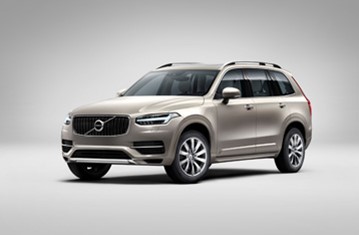
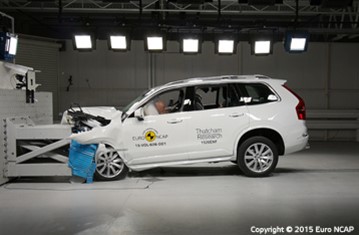
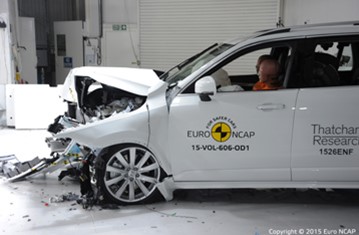
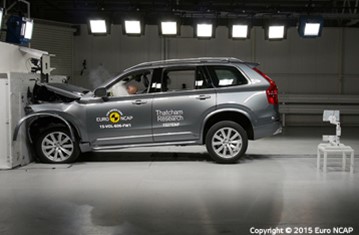
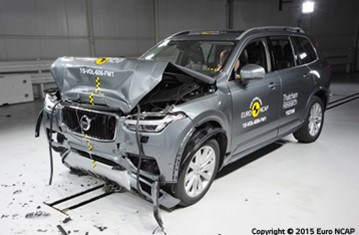
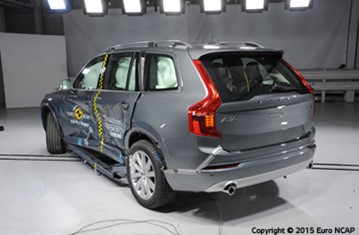
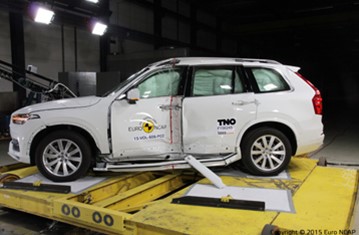



The passenger compartment of the XC90 remained stable in the frontal offset test. Dummy readings indicated good protection of the knees and femurs of both the driver and passenger. Volvo demonstrated that a similar level of protection would be provided to occupants of different statures and to those sat in different positions. In the full-width rigid barrier test, protection of the driver dummy was good for all critical body areas. For the rear passenger, protection of the chest was adequate and that of all other body regions was good. In the side barrier test, the XC90 scored maximum points with good protection of all critical body areas. In the more severe side pole impact, protection of the chest was adequate and that of all other body regions was good. In the original side pole test and to a lesser extent in the side barrier test, the side curtain airbag failed to deploy to its full extent at its rearmost edge. This would have resulted in protection for those in the optional third row seats that was less than Volvo had intended. Volvo investigated the cause and have implemented into production a modified trim panel which allows the airbag to deploy as intended. Euro NCAP's assessment is based on the updated vehicle currently being produced and Volvo will contact owners of cars with three seat rows in order to retro-fit the modified component. The front seats and head restraints provided good protection against whiplash injury in the event of a rear-end collision. A geometric assessment of the rear seats indicated good whiplash protection also for occupants of those seats. A standard-fit autonomous emergency braking system operates from the low speeds typical of city driving at which many whiplash injuries occur. The system scored maximum points in Euro NCAP's tests, bringing the car to a halt before collision at all test speeds.